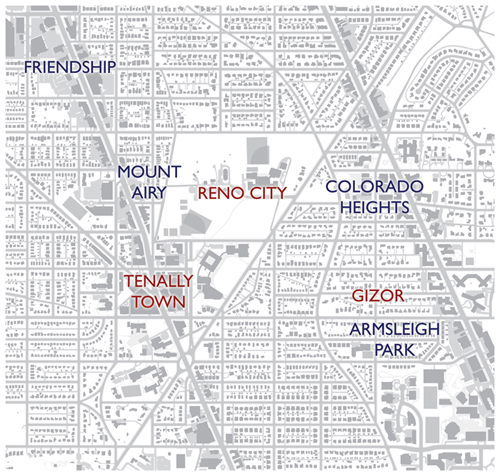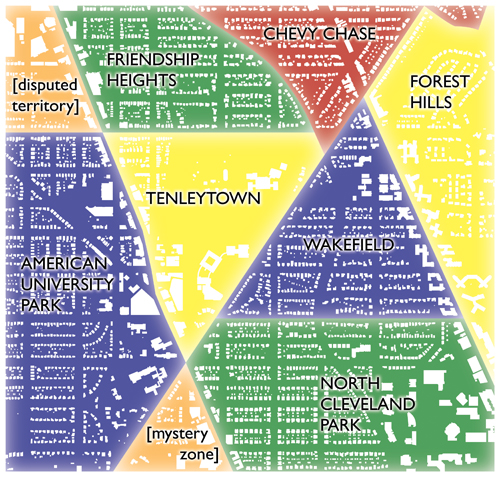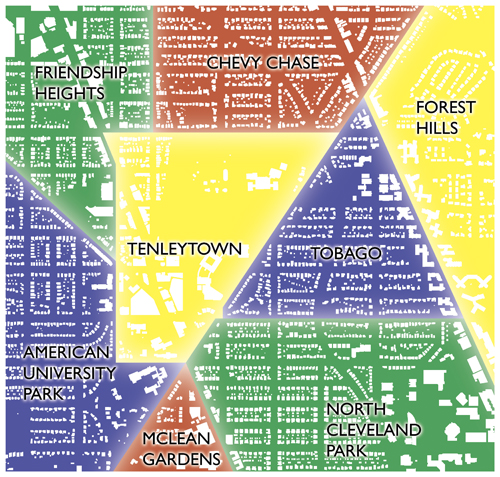Loyal readers of цarьchitect probably know that I hate the official name of the neighborhood I grew up in, North Cleveland Park “Wakefield.” Hopefully, that name will finally die. But my grouchiness about this coincided with an interest in the way that architects determine, delineate, and represent the concept of place. The goal of renaming an insignificant neighborhood in DC did dovetail nicely with my less modest plans to overturn planning and real estate practice.
So, the stupid name I did not know until I was 23 forms the starting off point for this discussion. That name lacks the lacecurtain cachet of “North Cleveland Park” or the actual uniqueness of “Tenleytown.” It’s a white-bread name reminiscent of too many other suburban developments. And, in fact, most of the area West of Connecticut Ave, North of Albemarle St., and East of Nebraska Ave was developed shortly before World War II and is one of the last areas to be developed as a tract in DC.
Because this name and others in the area came with the developments, neighborhood names tend to be bounded by major roads. Yet the centers of community and busy commercial areas. So, residents have ended up with indistinct locations bearing forgotten names and very popular ones with no names but provisional monikers, like “Comet Corner” and “Van Ness.” Or, according to City Paper, the area consists of Upper Caucasia, Connecticut, and Subarubia.
People have been attempting to name the area between Chevy Chase and Cleveland Park for over a century. Tenleytown may have grown up around John Tennally’s Tavern, but family names like Nourse and Dryer have disappeared from maps. In the late 1900s, the first developers came along and tried to add Armsleigh Park, Colorado Heights, Mount Airy, and Gizor. What seems to make a difference in whether the names stuck or not is whether the neighborhood has a clear social and commercial center. Tenleytown and Georgetown have such places. Forest Hills and AU Park do not.
Continues
Now, the names of the neighborhoods today are not any better than the ones lost to time. Just for example, here’s how Wikipedia divides the area, based on real estate convention:
Here, neighborhood divisions pass right through the centers of activity, such as on Wisconsin Ave. By this map, the vast majority of what people regard as Tenleytown is not in Tenleytown, such as the Janney School, Cityline at Tenley, and the Tenley-Friendship Library hole. It is as though the places where most neighborhood activity occurs have no bearing on the official geography. With that in mind, I asked some friends where neighborhoods begin and end. Here’s what I came up with:
In my opinion, this map reflects the general image of neighborhoods better, especially in the way it characterizes Tenleytown, but it’s still somewhat imperfect. For example, the Comet Corner node at Connecticut and Nebraska is still stuck between Chevy Chase, Forest Hills, and Tobago. Or, take the Van Ness hub, which is technically split between Forest Hills and North Cleveland Park. And, good lord, parts of AU park are a mile from American’s main campus.
Now, crumby names may not actually harm the businesses at these locations, but I have found it strangely hard to explain to outsiders how to get to Politics & Prose. It just does not exist on the mental maps of most inhabitants of the region. The lack of landmarks or a transportation node might be one reason it’s unremarkable, but the fact that people have spontaneously named the area suggests that area is not so much lacking as the naming system is itself insufficient.
Although a line is drawn down the middle of Wisconsin Avenue, a person will not feel that the neighborhood changed when he or she crosses the street. Both sides of the street sit in the same space – and one perceives them as the same place. So, from an urbanist standpoint, it makes more sense to approach neighborhood names through the experience of space and human activity.
In the next post, I will explain my alternative and the concept of locality.


